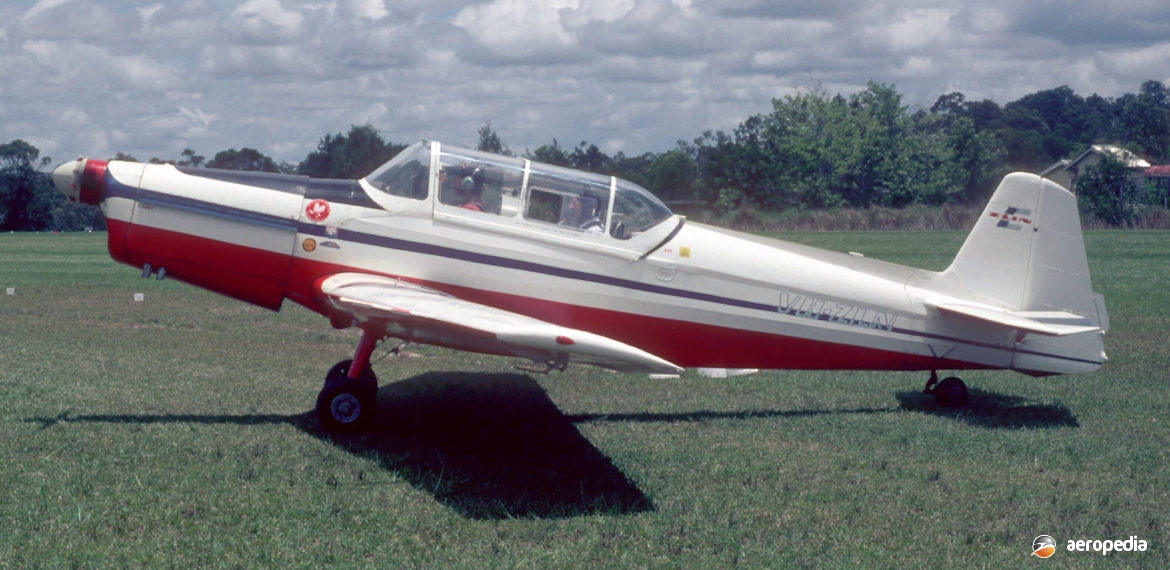Photograph:
Zlin Z 526F VH-ZLN (c/n 1091) in Queensland in 1992 (Tony Arbon)
Country of origin:
Czechoslovakia
Description:
Two-seat training monoplane
Power Plant:
One 119 kw (160 hp) Walter Minor 6-III six-cylinder in-line inverted air-cooled engine
Specifications:
- Wingspan: 10.60 m (34 ft 9⅓ in)
- Length: 8.01 m (26 ft 3 in)
- Height: 2.06 m (6 ft 9 in)
- Wing area: 15.45 m² (166.3 sq ft)
- Max speed at sea level: 243 km/h (151 mph)
- Cruising speed at 70% power: 212 km/h (132 mph)
- Initial rate of climb: 300 m/min (984 ft/min)
- Normal range: 579 km (379 miles)
- Range with auxiliary fuel tank: 1,030 km (640 miles)
- Empty weight: 666 kg (1,468 lb)
- Loaded weight: 975 kg (2,149 lb)
History:
The design of the basic Zlin Trener series was influenced by the Bucker Bu-181 Bestmann which was built under licence by the Moravan facility at Otrokovice after World War II. The Z 526 first flew in 1965 and was a progressive development of earlier models. It differed from the Z 326 primarily in having a controllable-pitch propeller in place of a fixed-pitch propeller, the introduction of which necessitated the re-positioning of the rear seat to the aft to maintain the centre of gravity position. A number of equipment changes were also made.
The Z 526 series was adopted by the British Aerobatic Team and flown by the late Neil Williams. In 1970 at the World Aerobatic Championships at RAF Hullavington in Wiltshire, UK the type was much in evidence, with the Czech team using three Z 526Fs, these being fitted with the M-137A fuel injected engine. East Germany used four, France one, Great Britain two, Hungary two, Italy one, Poland three and West Germany one Z 526, one Z 226 and one Z 326.
Later power of the Z 526 was increased by the installation of a 134 kw (180 hp) Avia engine with a constant-speed propeller, development further leading to the Z 526L Skydevil which had a 149 kw (200 hp) Lycoming IO-360 engine. This model was first flown on 27 August 1969 and series production commenced in 1971.
Production moved to the Z 526F and a clipped-wing aerobatic competition single-seat variant known as the Z 526AF, this being developed for the 1972 World Aerobatic Championships, having a modified canopy and a wingspan of 8.84 m (29 ft).
Last models in the series were the Z 626, embodying a number of refinements, which first flew in 1972, followed by the Z 726 which had a 157 kw (210 hp) Avia six-cylinder engine. Production of the series concluded in 1977. More than 1,600 examples of the series were delivered.
Construction of the fuselage was tubular steel with a stub wing assembly to which the wings, empennage etc were attached. The wings, tailplane and fins were of sheet metal construction, whilst the fuselage, rudder and elevator were of metal construction and fabric covered. The main undercarriage wheels were semi-retractable and electrically folded to the rear. The engine was a Walter Minor six-cylinder unit in- line inverted, with fully inverted fuel and oil systems.
Further variants developed included the Z 426, aimed at the agricultural market, which was not proceeded with due to the development of the Z 37.
An example of the Z 526F (c/n 1091) was imported to New Zealand and became ZK-CJY. This aircraft was exported to Australia and registered as VH-ZLN in September 1992. It was subsequently based at Tewantin, QLD for a few years. It has since returned to New Zealand and has been registered ZK-ZLN at Ardmore.

